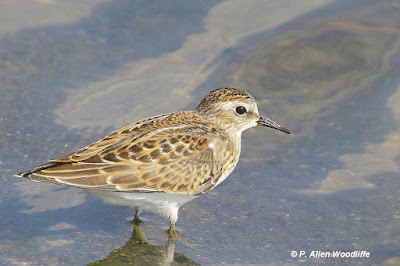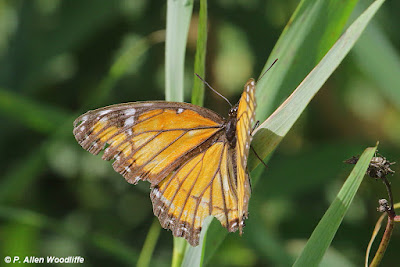There are lots of waterbirds on the move these days. While I have been out looking at rare orchids and other plants, that will wait for a later post.
I've been to St. Clair NWA recently, as it is not far from home, and if I choose a time or a route where there is no one else, it is extra pleasant for my tastes.
There is an ongoing presence of the aggressive and invasive Phragmites along the trail, which is somewhat unfortunate in that it obscures the view into the extensive wetland. But with the associated more natural vegetation along the way, there is lots of insect activity to be found.
Monarchs were abundant and most of the ones I saw were looking quite fresh.
There were a few crescents. This one is likely a Pearl Crescent, owing to the tip of the antennae not appearing to have any orange.
I thought this colour of a grasshopper was unusual. It might just be the relatively common Carolina Grasshopper.
Not an insect, obviously, but a critter that feeds on insects is this Leopard Frog. They were quite numerous along the trail.
There were quite a few swallows on the wires along the roadway, such as this Barn Swallow, considered a Species At Risk......
...and also along the trail and road entrance were a few Prairie Thistle, another Species At Risk.
One thing the Phragmites and other vegetation along the trail allows, is a closer approach to somewhat open areas in the dense cattails so as to get a relatively close view of the numerous Great Egrets scattered throughout the wetland. This first one was almost too close to focus on. This NWA, and almost any large wetland along Lake St. Clair, is one of the best places in Ontario to see this species. Of course it helps that there are at least a couple of egret colonies within a short flight distance of the NWA.
When they are startled from their feeding spot, they may circle several times affording some great photo opportunities.
Maybe if the water levels are appropriately lower over the next few weeks, there will be quite the spectacle of over-night roosting egrets, like this that occurred for several weeks in September and October of 2012. There were close to 150 birds using this spot. This photo was taken a few minutes before sunrise, using a long exposure. The birds were almost completely motionless. It is one of my many favourite memories of SCNWA, and I had a nice 24" X 8" canvas print made up of this photo.
Other large wading birds offer similar photo ops, but they aren't usually as numerous to begin with.
 | ||
| Great Blue Heron |
Sewage lagoons are popular for shorebirds. I've been to the Blenheim lagoons several times lately, as there has been a good variety of shorebirds, including some rarer ones. For example a young Red Knot has been seen periodically. I didn't get any photos of it, but here are the ones I managed to shoot.
Baird's Sandpiper were one of the rarer ones. It stood out with its wing tips extending beyond the tail. The long, slim wings really stood out when it was in flight.
 |
| Least Sandpiper |
 |
| Greater Yellowlegs |
 |
| Lesser Yellowlegs |
Pectoral Sandpipers were present in small numbers.
This young Ruddy Turnstone was a bit unusual. They are more often found along sandy shorelines of the local lakes.
 |
| Semipalmated Plover |
 | |
| Semipalmated Sandpiper |
There were lots of these sandpipers, with probably at least 75 or more around the lagoons in variable sized groups.
One of the highlights was not a water bird type at all, but at least one Peregrine Falcon, formerly an endangered species. It would be high in the sky, and then almost out of nowhere, come swooping in and flushing some shorebirds, hoping one would be vulnerable to be picked off. I didn't see it catch anything. Perhaps it was just practicing.It was hard to keep the focus locked on to the falcon as it sometimes flew low and fast. This species is the fastest animal on the planet, as they have been known to dive at speeds of over 300 km/hr! But of all the shots I took, I managed to get a small number with satisfactory results.
Non-shorebirds were not fazed at all by the falcon. These two Midland Painted Turtles were soaking up some sun.
If you would like to subscribe, or unsubscribe, to Nature Nuggets, send an email to: prairietramper@gmail.com


























Thanks for the post. Much appreciated. Always great to get out and enjoy nature.
ReplyDeleteThanks, Dave. It is indeed a treat to be able to get out and explore all the things there are to see!
Delete